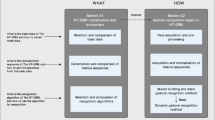Abstract
Recently, the recognition of posture and gesture has been widely used in fields such as medical treatment and human–computer interaction. Previous research into the recognition of posture and gesture has mainly used human skeletons and an RGB-D camera. The resulting recognition methods utilize models of the human skeleton, with different numbers of joints. The processing of the resulting large amounts of feature data needed to recognize a gesture leads to the recognition being delayed. To overcome this issue, we designed and developed a system for learning and recognizing postures and gestures. This paper proposes a gesture recognition method with enhanced generality and processing speed. The proposed method consists of feature collection part, feature optimization part, and a posture and gesture recognition part. We have verified the solution proposed in this paper through the learning and subsequent recognition of 29 postures and 8 gestures.













Similar content being viewed by others
References
Omelina, L., Jansen, B., Bonnechere, B., Van Sint Jan, S., & Cornelis, J. (2012). Serious games for physical rehabilitation: designing highly configurable and adaptable games. In Proceedings of the 9th international conference on disability, virutal reality & associated technologies, Laval, France, pp. 195–201.
Pirani, E., & Kolte, M. (2010). Gesture based educational software for children with acquired brain injuries. International Journal in Computer Science and Engineering, 2(3), 790–794.
Alves, S., Marques, A., Queirós, C., & Orvalho, V. (2013). LIFEisGAME prototype: A serious game about emotions for children with autism spectrum disorders. PsychNology Journal, 11(3), 191–211.
Zhang, K., Zhai, Y., Leong, H. W., & Wang, S. (2012). An interaction educational computer game framework using hand gesture recognition. In Proceedings of the 4th international conference on internet multimedia computing and service, pp. 219–222.
He, G. F., Park, J. W., Kang, S. K., & Jung, S. T. (2012). Development of gesture recognition-based serious games. In 2012 IEEE-EMBS International Conference on Biomedical and health informatics (BHI), pp. 922–925.
Kühnel, C., Westermann, T., Hemmert, F., Kratz, S., Müller, A., & Möller, S. (2011). I’m home: Defining and evaluating a gesture set for smart-home control. International Journal of Human–Computer Studies, 69(11), 693–704.
Taranta, E. M, I. I., Simons, T. K., Sukthankar, R., & Laviola, J. J, Jr. (2015). Exploring the benefits of context in 3D gesture recognition for game-based virtual environments. ACM Transactions on Interactive Intelligent Systems (TiiS), 5(1), 1–34.
Zhou, Y., Jing, L., Wang, J., & Cheng, Z. (2012). Analysis and selection of features for gesture recognition based on a micro wearable device. Graduate School of Computer Science and Engineering, University of Aizu Wakamatsu, Japan,(IJACSA) International Journal of Advanced Computer Science and Applications 3(1), 1–7.
Kang, S. K., Chung, K. Y., Rim, K. W., & Lee, J. H. (2011). Skin color based hand and finger detection for gesture recognition in CCTV surveillance. The Journal of the Korea Contents Association, 11(10), 1–10.
Juhyun, L., Hanbyul, C., & Kicheon, H. (2015). A fainting condition detection system using thermal imaging cameras based object tracking algorithm. Journal of Convergence., 6(3), 1–15.
Bostanci, E., Kanwal, N., & Clark, A. F. (2015). Augmented reality applications for cultural heritage using Kinect. Human-Centric Computing and Information Sciences, 5(1), 1–18.
Kessous, L., Castellano, G., & Caridakis, G. (2010). Multimodal emotion recognition in speech-based interaction using facial expression, body gesture and acoustic analysis. Journal on Multimodal User Interfaces, 3(1–2), 33–48.
Zhang, Z., Liu, Y., Li, A., & Wang, M. (2014, October). A novel method for user-defined human posture recognition using Kinect. In 2014 7th international congress on image and signal processing (CISP), pp. 736–740.
Patsadu, O., Nukoolkit, C., & Watanapa, B. (2012, May). Human gesture recognition using Kinect camera. In 2012 international joint conference on computer science and software engineering (JCSSE), pp. 28–32.
Le, T. L., Nguyen, M. Q., & Nguyen, T. T. M. (2013, January). Human posture recognition using human skeleton provided by Kinect. In 2013 international conference on computing, management and telecommunications (ComManTel), pp. 340–345.
Wu, J., Cheng, J., & Feng, W. (2014, July). 3D dynamic gesture recognition based on improved HMMs with entropy. In 2014 IEEE international conference on information and automation (ICIA), pp. 213–218.
Park, C. B., & Lee, S. W. (2011). Real-time 3D pointing gesture recognition for mobile robots with cascade HMM and particle filter. Image and Vision Computing, 29(1), 51–63.
Fujii, T., Lee, J. H., & Okamoto, S. (2014). Gesture recognition system for human–robot interaction and its application to robotic service task. In Lecture notes in engineering and computer science: proceedings of the international multiconference of engineers and computer scientists, pp. 1–6.
Yang, M., Lin, Z., Tang, W., Zheng, L., & Zhou, J. (2014). Human action recognition based on Kinect. Journal of Computational Information Systems, 10(12), 5347–5354.
Huang, X., Zheng, L., Liang, R., & Wang, W. (2012). Human action recognition based on SVM using multiple features. International Conference on Artificial Intelligence and Soft Computing, 12, 160–165.
Li, P. C., & Xu, S. H. (2005). Support vector machine and kernel function characteristic analysis in pattern recognition. Computer Engineering and Design, 26(2), 302–304.
Baruah, U., & Hazarika, S. M. (2015). A dataset of online handwritten assamese characters. Journal of Information Processing Systems, 11(3), 325–341.
Acknowledgments
This research was supported by the MSIP (Ministry of Science, ICT and Future Planning), Korea, under the ITRC (Information Technology Research Center) support program (IITP-2016-H8501-16-1014) supervised by the IITP (Institute for Information & communications Technology Promotion) and by Basic Science Research Program through the National Research Foundation of Korea (NRF) funded by the Ministry of Science, ICT and future Planning (NRF-2015R1A2A2A01003779).
Author information
Authors and Affiliations
Corresponding author
Rights and permissions
About this article
Cite this article
Xi, Y., Cho, S., Fong, S. et al. Gesture Recognition Method Using Sensing Blocks. Wireless Pers Commun 91, 1779–1797 (2016). https://doi.org/10.1007/s11277-016-3356-z
Published:
Issue Date:
DOI: https://doi.org/10.1007/s11277-016-3356-z




